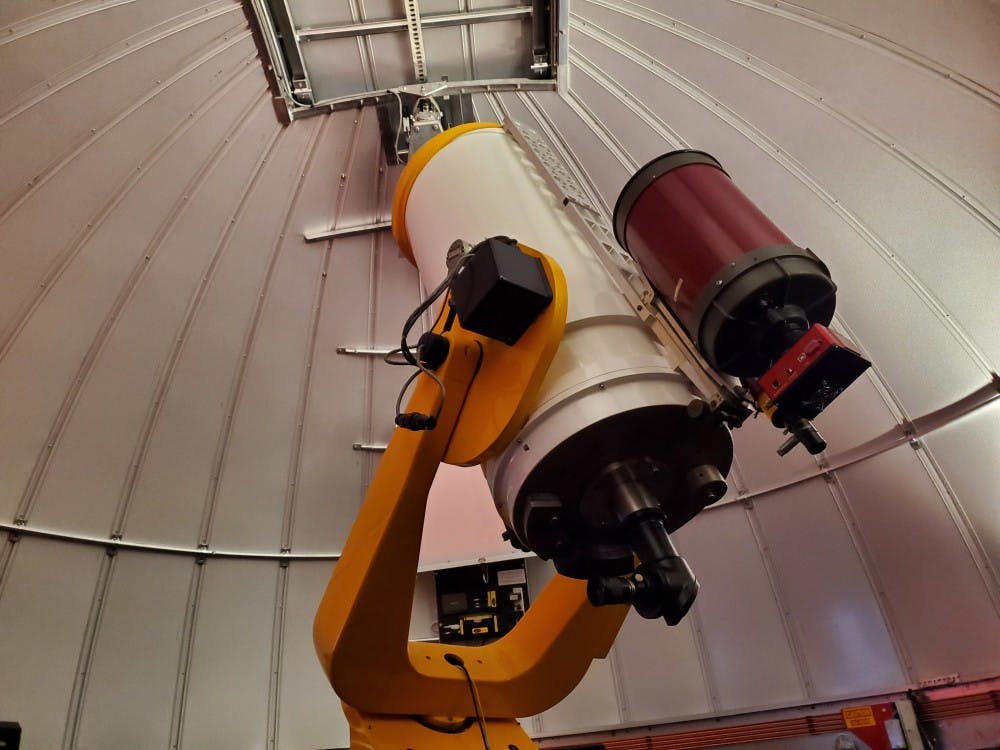Brooks Astronomical Observatory brings space down to Earth

DFM Engineering's Newtonian-Cassegrain telescope sits in the Brooks Astronomical Observatory Sept. 9.
They haven’t found aliens. They aren’t collaborating on top-secret research with the government. Instead, since 1976, the Brooks Astronomical Observatory has been opening its doors to Central Michigan University students and the greater Mount Pleasant community to share the wonders of space.
“Our primary goals with this observatory are two-pronged,” physics faculty member Aaron LaCluyze said. “Number one is training and teaching our undergraduate physics students. Number two is what I call public outreach.”
Rain or shine, residents of Mount Pleasant are welcome to a tour of the observatory during the academic year. They’ll see DFM Engineering’s $100,000 16-inch Newtonian-Cassegrain telescope. Installed in 1996, it can either be manually operated or controlled via computer. The new motor-powered dome that was built in 2011 is also featured; it rotates so the telescope can view any part of the sky.
Open houses are held once a month while school is in session. The next open houses will be 8-10 p.m. Monday, Oct. 7 and Tuesday, Nov. 5.
If weather permits, visitors are encouraged to bring and use their own telescopes on the observation deck. Likewise, the observatory’s telescope will only be used if there’s no chance of rain or snow that could damage the equipment.
“We’re very subject to the weather,” LaCluyze said. “Mid-Michigan is not the greatest place in the world for an observatory. When you build observatories, you want to go to higher altitudes so there’s less atmosphere between you and space – in fact, ideally, you’d just put it in space. You also want very still air, but we have a lot of weather here in Michigan. It changes on an hourly basis.”
The observatory faces another obstacle: light-pollution. There’s the light emitted from the rest of campus, especially from the library and football stadium, in addition to the lights coming from nearby Mission Street and the rest of the city.
“If you really want to do hardcore, cutting-edge research, you need a dark site,” LaCluyze said.
Despite these challenges, the observatory provides a suitable place for student projects and research that will prepare them for success.
LaCluyze and his students focus their research on pulsating variable stars. Unlike our sun which is comparably stable, these stars periodically increase or decrease in brightness according to their growing and shrinking in size. By recording these changes and running the right equations, astronomers can determine how far away that star is from Earth.
Regardless of whether future generations will travel to those distant suns, LaCluyze said there are practical reasons for justifying the study of space. We learn more about our own planet, sun, and moon. We also reap rewards as consumers.
“When asked why bother, that’s almost backward to me,” LaCluyze said. “If you look at the kind of advances we’ve made in technology, you have [the kind of studies we do here] to thank.
"Do you like the camera in your smart-phone? Do you like having lots of storage space? Astronomers are constantly pushing the envelope of computing power, storage capacity, and image processing.”
Whether you want to be an astronomer, or just play with a telescope, the Brooks Astronomical Observatory has opportunities for you.
“Nearly everyone at some point in their life has been fascinated with the sky, the stars, space, astronauts and all that jazz,” LaCluyze said. “A facility like this being located on campus in the heart of the community gives us a chance to bring that to the masses.”




